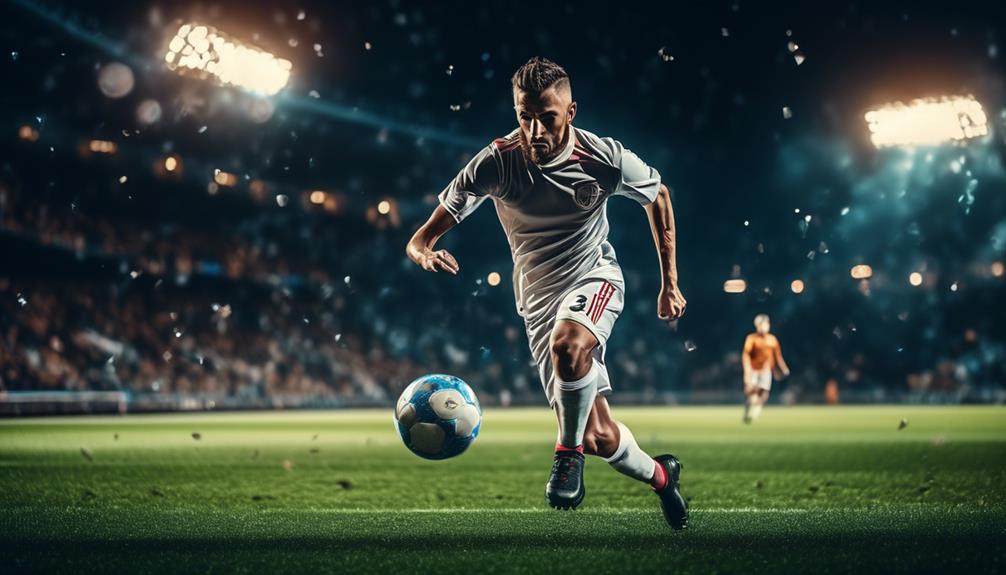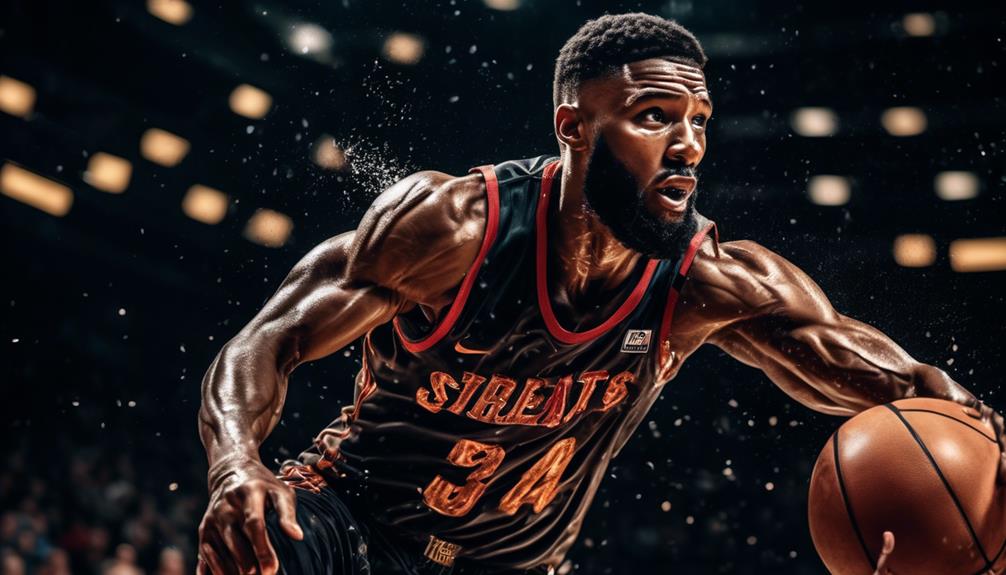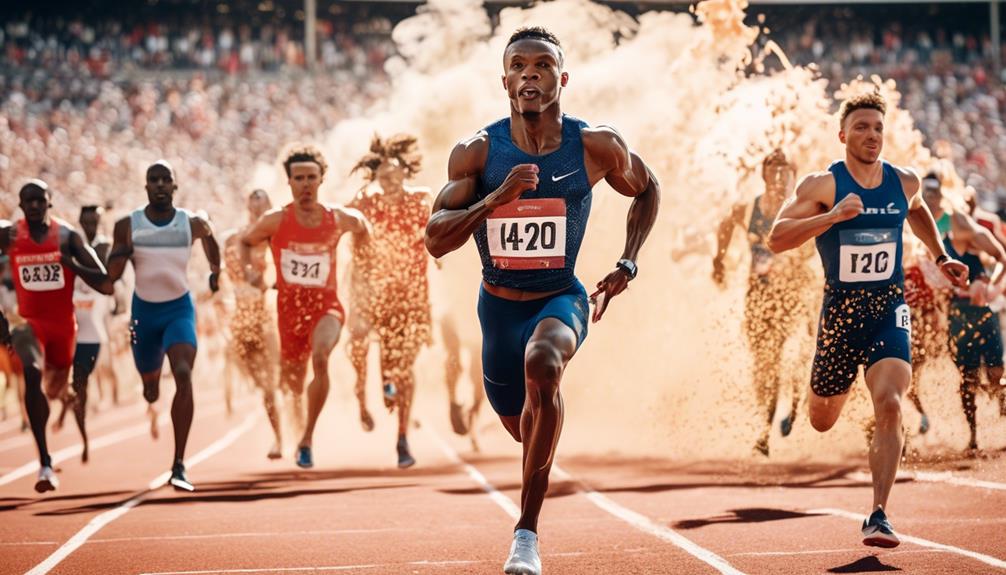Please note this post may contain affiliate links picked by me (Jay) that I have deemed may be of interest or relevant to you the reader of this.
These links do not affect the cost of the thing if you decide to purchase but i may get a little money if you choose to purchase.
For more information on my affiliate link policy click here.
As a sports action photographer, I've learned a few tricks of the trade that have helped me capture those split-second moments of intensity and athleticism. But here's something you probably don't know: it's not just about having a fancy camera or expensive lenses.
It's about understanding the key elements that make a great sports action photo. From mastering autofocus to anticipating the action, there are nine essential tips that can take your sports photography to the next level.
So, if you're ready to elevate your game and capture the heart-pounding excitement of sports, keep reading.
Key Takeaways
- Adjusting exposure settings, such as aperture, shutter speed, and ISO, is crucial for capturing sports action shots in challenging lighting conditions.
- Choosing the right lens, such as a zoom lens or telephoto lens, based on the type of sports and the desired focal length, can greatly enhance the quality and composition of the images.
- Understanding the role of shutter speed in freezing action or capturing motion blur is essential for capturing dynamic sports moments.
- Mastering autofocus techniques, like continuous tracking and experimenting with focus point settings, is necessary for capturing fast-moving subjects with precision in sports photography.
Camera Settings
When it comes to capturing the perfect sports action shot, getting your camera settings just right is essential. Adjusting exposure and overcoming camera shake are two key elements to consider in order to achieve outstanding results.
To begin with, adjusting exposure is crucial for capturing sharp and well-lit images. Sports events often take place in fast-paced and challenging lighting conditions, such as under bright stadium lights or in dimly lit indoor arenas. To overcome these challenges, it's important to understand how to control your camera's exposure settings. Experimenting with different combinations of aperture, shutter speed, and ISO will help you find the perfect balance and ensure that your photos are properly exposed.
Additionally, overcoming camera shake is vital for capturing sharp and blur-free sports action shots. Fast-moving athletes and quick action can make it difficult to keep your camera steady. To combat camera shake, consider using a tripod or monopod to stabilize your camera. If a tripod isn't feasible, try bracing yourself against a solid surface or using your body as a stabilizer. Furthermore, utilizing image stabilization technology, if available on your camera or lens, can significantly reduce the effects of camera shake.
Choosing the Right Lens
Are you ready to discover the perfect lens for capturing incredible sports action shots? Choosing the right lens is essential for getting those high-quality, dynamic images that truly capture the spirit of the game.
Here are three key factors to consider when selecting a lens for sports action photography:
1) Zoom lens: A zoom lens gives you the flexibility to adjust your focal length and capture shots from a variety of distances. This is especially useful for sports photography, where you may need to quickly switch between capturing the entire field and zooming in on a specific player or moment.
2) Prime lens: While a zoom lens offers versatility, a prime lens can provide you with superior image quality and a wider aperture. This allows for faster shutter speeds, which are crucial for freezing fast-paced action. Additionally, prime lenses often have a shallower depth of field, allowing you to create beautifully blurred backgrounds that make your subject stand out.
3) Consider the focal length: The focal length you choose will depend on the type of sports you plan to shoot. For capturing action from a distance, a telephoto lens with a longer focal length is ideal. On the other hand, if you're shooting in smaller venues or want to capture wider scenes, a wide-angle lens with a shorter focal length may be more suitable.
Understanding Shutter Speed
Now that we've the perfect lens for capturing those incredible sports action shots, let's dive into the world of understanding shutter speed and how it can take your photography to the next level.
Shutter speed is one of the most important settings to consider when freezing motion in sports photography. It determines the amount of time the camera's shutter is open, allowing light to hit the sensor. A faster shutter speed, such as 1/1000th of a second or higher, will freeze the action, capturing crisp and sharp images of athletes in mid-air or in fast-paced movement.
To achieve the best results, it's crucial to anticipate the moment and use the panning technique. Panning involves following the subject's movement with your camera while using a slower shutter speed. This technique creates a sense of motion in your images, while still keeping the subject relatively sharp. It adds a dynamic element to your photographs, making them come alive.
Experimenting with different shutter speeds is key to mastering sports action photography. Try using slower shutter speeds, like 1/250th of a second, to capture some motion blur and convey a sense of speed. On the other hand, faster shutter speeds, like 1/2000th of a second, will freeze the action completely, allowing you to capture the peak moment of a jump or a sprint.
Understanding shutter speed is essential for capturing stunning sports action shots. By mastering this aspect of photography, you can freeze motion and use the panning technique to create images that truly stand out. So, grab your camera, head out to the field, and let shutter speed elevate your sports photography game to new heights.
Mastering Autofocus
To take your sports action photography to the next level, mastering autofocus is essential. The ability to capture fast-moving subjects with precision can make a world of difference in your shots. Here are three key tips to help you become a master of autofocus:
- Utilize continuous tracking: This feature allows your camera to follow the subject as it moves, ensuring that it remains in focus throughout the action. By activating continuous tracking mode, you can keep your focus locked on the subject, even if they change direction or speed.
- Understand focus points: Modern cameras have multiple focus points that you can select manually or let the camera choose automatically. It's important to understand how these focus points work and how to use them effectively. Experiment with different focus point settings to find the one that works best for your specific shooting situation.
- Practice, practice, practice: Mastering autofocus takes time and practice. Familiarize yourself with your camera's autofocus system and spend time shooting different sports and action scenarios. The more you practice, the more comfortable and proficient you'll become at capturing those split-second moments with precision.
Capturing the Decisive Moment
Capturing the decisive moment in sports action photography is all about timing and anticipation. It's that split second when the athlete leaps, the ball is caught mid-air, or the winning goal is scored. As a photographer, freezing motion and capturing emotions in that fleeting moment can create powerful and dynamic images that tell a story.
To help you understand the importance of timing and anticipation in sports action photography, take a look at the table below:
| Timing | Anticipation | Result |
|---|---|---|
| Pressing the shutter at | Predicting the athlete's | A perfectly timed shot |
| the right moment | movements | capturing the action |
| Being aware of the | Understanding the game | An image that showcases |
| key moments in a game | dynamics and anticipating | the intensity and |
| the athlete's next move | determination | |
| Reacting quickly to | Anticipating the right | A photograph that captures |
| unexpected events | moment to press the shutter | the raw emotions |
| of the athletes |
Composition and Framing
With a solid understanding of timing and anticipation, the next step in taking captivating sports action photos is mastering the art of composition and framing. This crucial aspect of photography allows you to create visually dynamic and engaging images that draw viewers into the action. Here are three key techniques to enhance your composition and framing skills:
- Utilize leading lines: Leading lines are elements within the frame that guide the viewer's eye towards the main subject. Look for natural lines such as roads, fences, or the direction of players' movements. Incorporating these lines into your composition can add depth and create a sense of movement within the image.
- Apply the rule of thirds: The rule of thirds is a classic compositional guideline that suggests dividing your frame into a 3×3 grid and placing your subject along the intersection points. This technique adds balance and visual interest to your photos, making them more aesthetically pleasing.
- Experiment with different perspectives: Don't be afraid to get creative with your angles. Try shooting from low to the ground for a unique and dynamic perspective. Alternatively, capturing the action from a higher vantage point can provide a broader view of the scene. Remember, innovation in composition leads to compelling and visually striking sports action photos.
Anticipating the Action
As a sports action photographer, I'm always on the edge of my seat, ready to capture the electrifying moments that unfold before my lens. Anticipating the action is crucial in capturing those split-second moments that define the essence of sports. To do this effectively, I ensure that my equipment is primed and ready to go. I double-check my camera settings, making sure my shutter speed is fast enough to freeze the movement. I also set my autofocus to continuous mode, enabling me to track the subject as they move across the frame.
In addition to preparing my equipment, I constantly keep my eyes on the field, anticipating the players' movements. I study their body language, looking for signs that indicate an imminent action. Whether it's a sprinter crouching at the starting line or a basketball player preparing to jump, these subtle cues help me predict the action before it happens.
When the moment arrives, I use my skills to capture the movement with precision. I follow the subject's trajectory, adjusting my position and framing to ensure I capture the peak of the action. I focus on the athlete's facial expressions, the intensity in their eyes, and the power in their movements. By capturing these dynamic elements, I create images that convey the energy and emotion of the sport.
Anticipating the action is a skill that requires practice and experience. It's about being fully present in the moment, ready to react and capture that split-second of magic. So, next time you find yourself behind the lens, remember to prepare your equipment and keep your eyes peeled for those captivating moments of movement.
Dealing With Low Light Conditions
When faced with low light conditions, I employ a variety of techniques to ensure that my sports action photography remains vibrant and captivating. Here are three effective ways I deal with low light situations:
- Using external lighting: When the available light is insufficient, I rely on external lighting sources to illuminate the scene. I often use portable strobes or continuous lights to add brightness and bring out the details in the action. This allows me to freeze the motion and capture the athletes in all their glory, even in dimly lit environments.
- Adjusting ISO settings: ISO is the camera's sensitivity to light, and increasing it can help in low light conditions. By pushing the ISO higher, I can capture more light and reduce the risk of blurry images. However, I'm careful not to go too high, as it can introduce noise and decrease image quality. Finding the right balance is key to achieving sharp and noise-free sports action shots.
- Utilizing fast lenses: Investing in fast lenses with wide apertures allows more light to enter the camera, enabling faster shutter speeds and reducing the need for high ISO settings. These lenses are invaluable in low light situations, allowing me to freeze the action with crispness and clarity. They also create a beautiful depth of field, isolating the subject and creating an artistic touch to my sports photographs.
Post-Processing and Editing Techniques
To enhance the impact of my vibrant and captivating sports action photography, I employ a range of post-processing and editing techniques that bring out the best in my images. These advanced editing techniques allow me to push the boundaries of creativity and innovation, resulting in truly stunning photographs.
One technique that I find particularly useful is enhancing motion blur. Sports action photography is all about capturing the dynamic movement of athletes, and enhancing motion blur can really make the image come alive. By selectively blurring certain elements of the photo, such as the background or the limbs of the subject, I can create a sense of speed and energy that adds excitement to the image.
Another important aspect of post-processing is adjusting the colors and tones to make them pop. This involves tweaking the saturation, contrast, and exposure levels to bring out the vibrant colors of the sports uniforms or the intensity of the action. I also use techniques like dodging and burning to selectively lighten or darken certain areas of the image, enhancing the overall composition.
In addition to these techniques, I also make use of specialized software and plugins that offer a range of creative options. These tools allow me to experiment with different effects, such as adding texture or creating unique color grading, to give my sports action photography a distinctive and artistic look.
Frequently Asked Questions
What Are Some Common Mistakes to Avoid When Shooting Sports Action Photography?
When shooting sports action photography, it's crucial to avoid common mistakes that can hinder the quality of your shots. Lighting techniques play a vital role in capturing the action effectively.
By understanding how to work with different lighting conditions, you can ensure that your subjects are well-illuminated and their movements are frozen in time.
How Can I Effectively Capture the Emotions and Intensity of a Sports Event Through Photography?
To effectively capture the emotions and intensity of a sports event through photography, it's all about capturing those fast-paced moments and nailing the timing and composition. Being in the right place at the right time is essential.
By juxtaposing the intensity of the action with the raw emotions on the faces of the athletes, you can create a powerful image that truly captures the spirit of the event.
It's about innovation, creativity, and bringing out the essence of the sport in every shot.
Are There Any Specific Techniques or Tips for Photographing Indoor Sports Events?
When it comes to photographing indoor sports events, there are some key tips and techniques to keep in mind.
First, lighting plays a crucial role in capturing the action accurately. Make sure to adjust your camera settings accordingly and consider using a fast lens to let in more light.
Additionally, composition is important for indoor sports photography. Look for interesting angles and try to frame the athletes in a way that highlights their intensity and skill.
With these techniques, you can capture the thrilling moments of indoor sports with precision and creativity.
What Are Some Recommended Camera Accessories for Sports Action Photography?
When it comes to sports action photography, having the right camera accessories is a must. These recommended camera accessories can make a world of difference in capturing those fast-paced moments.
From a reliable telephoto lens for getting close to the action, to a sturdy tripod for stability, and a high-speed memory card for quick and seamless shooting, these must-have equipment can help elevate your sports photography game to new heights.
Don't miss out on capturing those epic moments with the right camera accessories.
Can You Provide Some Advice on How to Approach and Interact With Athletes to Capture Authentic Moments During a Sports Event?
Approaching athletes and capturing candid moments during a sports event is all about building a connection and being in the right place at the right time. It's essential to approach athletes with respect and enthusiasm, showing genuine interest in their performance.
Conclusion
In conclusion, capturing sports action photography requires a combination of technical knowledge and artistic skill.
By mastering camera settings, understanding shutter speed, and choosing the right lens, photographers can freeze the fast-paced moments that define sports.
With practice and anticipation, they can capture the decisive moments that tell a compelling story.
And by using post-processing techniques, photographers can enhance their images and bring out the vibrant colors and details that make sports photography come alive.
For example, imagine capturing a soccer player's mid-air kick, frozen in time, showcasing their skill and determination.
With these essential tips, anyone can take their sports photography to the next level.


